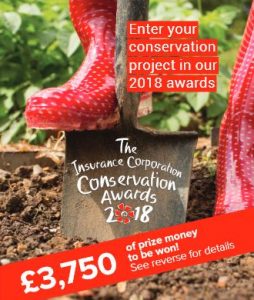By Liz Corry
Spoiler alert! Ronez Quarry found the first hatched egg shell of the year on 23rd May. However, there are so many more things to report about from May that we will leave that golden nugget of information for later.
Spreading their wings
Reports continue to come in from both the south-west and north-west corners of the island. The pair roosting in St Ouen’s Bay repeatedly foraged around Corbière Lighthouse, the desalination plant, and the sand dunes. And they are just the places we know about. I suspect they have taken a cheeky gander at the golf courses that lie to the north and south of their roost.

Choughs foraging by the old radio tower at Corbiere. Photo by Liz Corry.

Mary and Bo searching for found near the lighthouse. Photo by Liz Corry.
Looking at the hard granite around Corbière you would think it slim pickings on the menu for the chough pair. However, if you watch closely they are quite adept at finding tasty morsels. Take a look at this video for example. Not entirely sure what it is they have found, but obviously in high demand.
There is plenty of food on offer closer to the release site. Thanks to a local resident sending in a photo, we found a group of choughs hanging out at a ‘secret’ spot behind Sorel Farm. A horse field currently vacant except for rabbits, pheasant, swooping house martins, and aforementioned choughs. Short pasture, dung, and very little disturbance. Idyllic. For choughs at least.
This is a video of a few in a different horse field by the quarry.
The pair at Plémont are still going strong. They abandoned their nest in a sea cave and relocated to a crevice outside. We have not seen them at Sorel for a very long time. They appear to be finding plenty of food where they are. As the swifts start their summer residency in the same area we could be in for some interesting interactions. It is certainly an impressive sight to see the acrobatic flights of both species together.
Chough exchange

On 22nd May four choughs from Jersey Zoo were caught up and transported to Paradise Park as part of our animal collection exchange. The birds travelled by boat in the Zoo van driven by our Head of Operations and a senior mammal keeper.
None of the choughs hold a valid license.
Gwinny, one of the four, has been with us at the Zoo since the very beginning. However, she failed to find a partner who shared her chick rearing aspirations. Maybe she will find her Mr Right in Cornwall.
On the return trip the van was loaded up with four different choughs, two Namaqua doves and a Madagascar partridge (pear tree to follow). They travelled on the freight ferry which meant a 4am, repeat 4AM!!, arrival in Jersey – a fog covered Jersey to boot.

Two new arrivals to a fog bound Jersey at sunrise (not that you can tell). Photo by Liz Corry.
Two of the choughs headed to Sorel where they will spend a month in quarantine acclimatising to life on the coast. We moved Han Solo, Jersey Zoo’s male, to the aviary the day before they arrived.
All three looked to be in good condition. We discovered Han Solo had a new claw growing through suggesting damage at an earlier date. He clearly has not been in any discomfort so no need to treat him.

A new claw growing out after previous damage resulted in loss of the old claw. Photo by Liz Corry.
The three boys will be housed separately to the free-ranging choughs during quarantine with opportunity to socialise (between ‘bars’) at feed times. In fact the first meeting between the two groups happened within minutes of reaching Sorel. Lots of shouting and displaying from the outside group at first thought to be directed at the newbies. After ten minutes of observations it became apparent they were just after the food locked away inside!
If all goes to plan the two males from Paradise Park and Han Solo from the Zoo will be released at the start of July.
In case any of you were curious as to the names of Han’s new friends…Chewbacca and Skywalker of course.

Let the judging commence

Judges visited Jersey’s short-listed contenders for this year’s Insurance Corporation Conservation Awards on May 23rd.
Ronez Quarry nominated our chough project for the work we do in collaboration with them to monitor and protect the wild population.
The quarry has been home to the choughs since the first soft-release back in 2013. This season we had at least eight pairs trying to raise chicks in the quarry.
Winners will be announced on 27th June. There are several awards up grabs with a total prize fund of £3,750. One of the awards is a People’s Choice Award worth £500. Social media voting will begin in June – get clicking!

Insurance Corporation Conservation Awards judges at Ronez Quarry. 23rd May 2018. Photo by Liz Corry.
If we are fortunate enough to receive any money it would go towards providing an educational experience for school groups visiting the quarry. A chance to learn about natural resources, coastal conservation, and of course the choughs. Any remaining money would go towards covering the costs involved in ringing and DNA sexing chicks (approximately £18 per chick).

Ronez Quarry
Wild nest updates
If all goes well then Han Solo and the boys will be joined by several wild-hatched fledglings in July. The day the judges visited the quarry was the same day we discovered the first chicks of 2018 had hatched.
Toby Caberet had found hatched egg shell near one of the known nest sites. Using a handheld endoscope camera we were able to confirm a record number of four chicks in a single nest.

Four recently hatched chough chicks in a nest at the quarry. Photo taken under licence by Toby Caberet.
This is amazing news as this particular pair are first time parents. The chicks are very young. They have a further six weeks before leaving the nest and, as we learnt last year, that still doesn’t guarantee they will make it to Sorel. As long as the parents can find enough insects they stand a good chance.
All the more reason to rejoice in the next bit of news.
(St) Mary had a little lamb, and St John and St Peter…
This month the Manx loaghtan lambs were moved from the farm in St Catherine’s to the grazing site at Sorel. They are now old enough to roam the cliff tops. Still very vulnerable. Bleating can be heard far and wide from ‘lost’ lambs whose mothers are two feet away hidden in the gorse. Please remember to close gates and keep dogs under control. Any mountain bikers, be alert! It might not be a brown rock on the path that you are about to ride over.

Ewes and their lambs are now out roaming free at Sorel. Photo by Liz Corry.
A new grazing site in St Peter’s Valley has become home to another flock of Manx loaghtan sheep brought in to graze the meadows and hopefully improve biodiversity in the area. You can see them if you visit Quetivel Mill, a National Trust property open every Monday and Tuesday (10am-4pm).

Lambs are now out and about at Sorel. Photo by Liz Corry.
And finally, we couldn’t sign off without including the following picture taken by Mick Dryden at Sorel Point. A rare spring migrant to the Island, a honey-buzzard, flying alongside one of our choughs. I bet that was a sight no one predicted they would see five years ago!

Honey-buzzard and chough at Sorel Point. Photo by Mick Dryden.

 From
From 


 From
From 
 Go wild
Go wild Netting, garden string and other litter can all be hazards for hedgehogs.
Netting, garden string and other litter can all be hazards for hedgehogs.
 From
From 
 From
From 


 Having got to where we are, many have asked; How has this all come about ? Well, in the autumn of 2015 The
Having got to where we are, many have asked; How has this all come about ? Well, in the autumn of 2015 The  weekend first island visit in November 2015, was a major factor in Cathy and I deciding to move to Alderney from Kent in March 2016. These early discussions brought about a 2-year observatory establishing pilot project supported by the Wildlife Trust, its primary remit to try and achieve bird observatory accreditation status from the Bird Observatories Council. Local interest and support for this project from the outset was exceptional and largely through Paul’s contacts we soon had a very experienced and capable bird observatory committee driving things forward.
weekend first island visit in November 2015, was a major factor in Cathy and I deciding to move to Alderney from Kent in March 2016. These early discussions brought about a 2-year observatory establishing pilot project supported by the Wildlife Trust, its primary remit to try and achieve bird observatory accreditation status from the Bird Observatories Council. Local interest and support for this project from the outset was exceptional and largely through Paul’s contacts we soon had a very experienced and capable bird observatory committee driving things forward.




 From
From 

 From
From 
 From
From 
 In what has become a tradition, each year at around this time Birds On The Edge can unveil the updated list of Channel Islands birds. With kind support from our friends in the very active birding communities in Guernsey, Alderney, Sark and Jersey the list, updated to the end of 2016, can be downloaded
In what has become a tradition, each year at around this time Birds On The Edge can unveil the updated list of Channel Islands birds. With kind support from our friends in the very active birding communities in Guernsey, Alderney, Sark and Jersey the list, updated to the end of 2016, can be downloaded  What has changed since the last list (to the end of 2015)? Well, that is very obvious to anyone looking closely at the species records and stems from the launch last year of the
What has changed since the last list (to the end of 2015)? Well, that is very obvious to anyone looking closely at the species records and stems from the launch last year of the 





